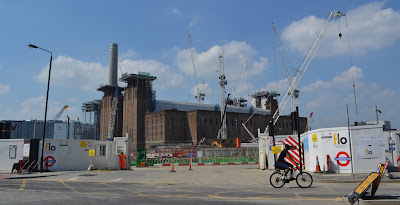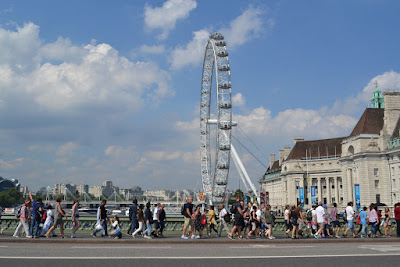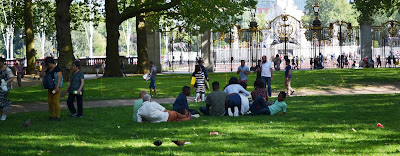20 July 2016
All day
We started from Sloane Square Royal Hospital
Road London Chelsea Physic Garden London
|
Spreading yellow-sorrel
Cock's-eggs
|
Red-veined dock &
annual pearlwort
Ivy broomrape
|
The last was a
mystery at first, because all the spikes were coming up in an empty cleared
bed, and there were none of the usual clover family around on which common
broomrape is usually found. Close
examination revealed it to be ivy broomrape Orobanche
hederae, a surprise because it is usually seen as a western and coastal
species. A look at the BSBI Atlas,
however, showed that it is regularly recorded in London
There were plenty of interesting
planted species, of course, but those we particularly noted, as they can appear
in the wild, were crimson clover Trifolium
incarnatum (grown in a meadow plot
as a bee attractant), chamomile Chamaemelum
nobile, and coriander Coriandrum
sativum.
Chamomile
Coriander
There were many
displays of plants notable for their scents (good or bad), which would make it
an amenable place for visually impaired visitors. We also noticed a gall on the leaves of grape
vines Vitis vinifera, caused by the
mite Colomerus vitis, a recent immigrant
to this country, and mines in the leaves of sugar beet Beta vulgaris where a fly Pegomya
sp. was feeding.
Galls of Colomerus vitis on grape vine
Leaf-mines of Pegomya sp. on sugar-beet
More exotic
species, including a good display of pitcher plants, were grown under glass,
including the endangered Notacactus
woollii. Although we did not hear
any, the frequent presence of ring-necked parakeet was indicated by the finding
of a narrow vibrant-blue tail feather.
|
|
Parakeet feather against
cork oak Quercus suber bark
|
Leaving the Physic Garden
we walked to the end of Swan Lane Thames , which we
were to follow much of the day. Across
the other side was our next destination, Battersea Park Japan
Peace Pagoda in Battersea Park
To get to the park
we had to walk upstream a short way to Albert Bridge, which is a hybrid
structure - part cable-stayed (1873), part suspension (1884-87) and part simple
beam structure with two piers (1973), reflecting structural weaknesses of the
original design. It vibrates markedly
when large numbers of people cross: there are still signs for troops to break
step. On the far side of the bridge was
a fenced off area of wasteland dominated by giant plants of docks, hemlock
water dropwort Oenanthe crocata and
garden angelica Angelica archangelica.
Garden angelica, docks, etc
at end of Albert Bridge
Among them were
also Mexican fleabane Erigeron
karvinskianus, black horehound Ballota
nigra, buddleia Buddleja davidii,
and black nightshade Solanum nigrum subspecies
schultzii. Entering the park at its NW corner we proceeded
SE to the lakes area, passing through groves where the introduced ivy Hedera helix 'Green Ripple' carpeted the
ground with its jagged leaves and prominent veins, as well as native
enchanter's nightshade Circeaea lutetiana.
'Green Ripple' ivy
Around the lakes
are scattered a few old trees that have achieved "Champion" status
and we found most of these. There was a
narrow-leaved ash Fraxinus angustifolia,
an evergreen oak Quercus ilex, a
hybrid strawberry-tree with red bark Arbutus
x arachnoides, and a few London planes Platanus
hispanica.
|
Narrow-leaved ash
Hybrid strawberry-tree
|
Evergreen oak
|
We also saw a
specimen of an unusual form of sweet chestnut Castanea sativa 'Variegata'.
Sweet chestnut 'Variegata'
Perfoliate
alexanders Smyrnium perfoliatum,
presumably planted originally, was spreading vigorously, as it does at Kew . Other natural
invaders were black mustard Brassica
nigra, water bent Polypogon viridis,
and small nettle Urtica urens (with
the mines of the fly Agromyza
pseudoreptans, being apparently the first report in Britain for this
particular plant, although the fly is British and it feeds on small nettle in
Europe).
Leaf-mines of Agromyza pseudoreptans on small nettle
The ponds, which
had a bad irruption of algal scum, contained Canadian pondweed Elodea canadensis and supported the
usual birds, including heron, moorhen, coot, mallard, mute swan (one pair with
nine cygnets) and Egyptian goose.
|
Heron and moorhen and
algal scum
|
Egyptian geese
|
La Gondola café at
the far end of the lakes was our intended stop for a lunch snack, but it was
closed, perhaps for some time, as the online reviews it had received were
abysmal! So we soldiered on to the
park's SE corner and left for Battersea Park Road, walking along it in the
direction of Battersea Power Station, which prevented access along the Thames
after the park for some while. Most food
outlets here were uninviting, but we eventually came across a traditional old
pub, The Duchess, which was modernised in 2014, still offers "homemade
minced beef and onion pie, mash and liquor", as well as real ales and
craft ciders. It was a lucky chance
find.
Across the road is
the power station, which is being restored - most of the chimneys had been
removed, as they were in poor condition, but they are to be rebuilt. The whole site is being developed with
apartments blocks and other facilities.
Battersea Power Station
reconstruction
We went past it
along Nine Elms Road London Thames embankment, walking by the
river in front of all these shiny new developments.
New apartments, St George
Wharf. Café is StEaX ("steaks" - GeT iT? yawn, yawn)
Occasionally
plants cropped up in the cracks of pavements or on the embankment itself,
including thale cress Arabidopsis
thaliana, annual mercury Mercurialis
annua, black nightshade, Oxford
ragwort Senecio squalidus, stone
parsley Sison amomum, and common
liverwort Marchantia polymorpha. There were birds on the river - cormorant as
well as Canada Vauxhall Bridge
|
MI5 fortress
|
Standard dolphin
lamp-standard
|
Soon we were
opposite the Houses of Parliament, while on our right we passed a little park
in front of St Thomas
We were fast
approaching the London Eye as we reached Westminster Bridge and turned left
over the Thames, joining throngs of tourists.
The road
continuing from the bridge passes the north side of the House of Commons, now
surrounded by more security fences than ever before. (Despite the fact that it has been a
terrorist target from at least 1605 when Guy Fawkes led a foiled attempt to
blow it up.) Through the railings,
however, we could still see the row of six Indian bean trees Catalpa bignonioides thought to have
been planted in 1857 and now looking impressively old with their gnarled black
trunks and boughs. At this time they
were in flower - pyramidal clusters of
large white flowers with purple stamens and orange styles - a splendid sight
below the geometric rigidity of Big Ben.
|
Catalpa in flower
|
Row of Indian bean-trees
below Big Ben
|
Continuing west we
soon came to the SE corner of St James's Park.
Keeping to the east side and going a hundred metres north we came to a
rough area with a low fence, behind which stood two trees of interest. One was a Tibetan cherry Prunus serrula, not as large as the Catalpas, but with a
distinctive shiny red bark.
Trunk of Tibetan cherry
The other is
reputed to be perhaps the largest fig tree Ficus
carica in Britain
Fig grove, St James's Park
Moving west the
park is full of old London
The lake in St James's Park
with white pelicans
We walked on
westwards past more crowds of people offering snacks to the grey squirrels and
an ecologically-unsound gallimaufry of birds - herons, carrion crows, moorhens,
coots, black-headed gulls, red-crested pochards, Canada and red-breasted geese,
and of course feral pigeons - sufficient at least to keep us entertained with
little of botanical interest on show.
Red-crested pochard
St James's area
used to be called "Thorney
Island Green Park ,
which joins St James's Park at the latter's NW corner, just where the gilded
gates of Buckingham Palace shield a large statue of Queen Victoria
Through more London
Tired now by the
unexpected sudden heat-wave and dust of central London, we still managed to
walk east on Piccadilly past Fortnum and Masons, Burlington House and the Ritz,
to the little churchyard of St James's, with a busy market in front of the
church, but a more peaceful green area to the side, where a small strip of
"meadow" presumably sown, yielded betony Stachys officinalis, sweet cicely Myrrhis odorata. hairy St John's-wort Hypericum hirsutum and nettle-leaved bellflower Campanula trachelium. The last hosted the rust Coleosporium tussilaginis.
We were now ready for a meal at one of the many fine restaurants in Mayfair and there was time still for a film before
catching a train home. Botany in central
London
Nettle-laved bellflower









































Notocactus woolii labelled as originating in Wales and the Shetland Islands! That's a long way from home.
ReplyDelete